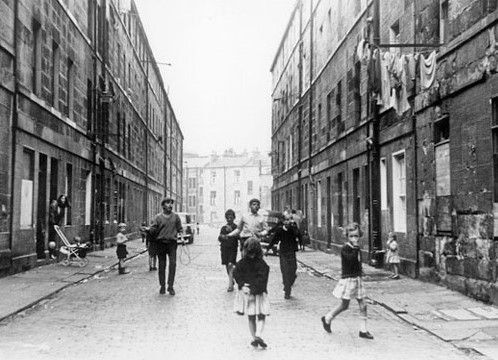Chapter One

11 Brecon Street
Their new home was a so-called room and kitchen. The ‘room’ was one small bedroom. The ‘kitchen’ was a modest-sized living room off which was a tiny alcove scullery consisting of a scrubbed wooden bunker, a deep porcelain sink with a single brass tap that issued only cold water, and an ancient gas cooker with two burners, a grill and an oven, that was powered by the municipal gas supply piped directly into the tenement. At least they could tell themselves that they had a separate ‘kitchen’. The living room window gave a view of tenement backs and so-called ‘greens’. A single fireplace with a high wooden mantlepiece provided the only heating. The coal was stored off the lobby in a lumber-room, something the size of a large cupboard. Adjacent to this was a toilet, but no bath or wash-hand basin, so they had to wash themselves - and Ian had to shave - in the scullery. There was a single electric power socket in the skirting board of the living room, which powered the radio, but electric light had never been connected and the Swanstons had to be content to live by gaslight as the Victorians had done. The walls were covered with ancient flowery wallpaper that was peeling in places and brown with age.
Granny Swanston’s meagre personal effects had been cleared out but her few sticks of furniture had been left for the new tenants. There was a bed, a wardrobe, an armchair, two dining chairs, a dining table and a decrepit, leather-bound bed settee. They found Granny Swanston’s wooden ironing board in the press. As well as the brown linoleum, here in the living room they had the added luxury of a threadbare carpet that managed to cover about half of the area. The Swanstons stood there, unsure for a moment. They’d known this only as their mother’s home – ultimately her last. But now it had become the step up they needed.
Brecon Street dipped abruptly from the spine of Junction Street and snaked down towards Bonnybrig Road. It was a long, narrow, cobbled thoroughfare, lined by dilapidated century-old tenements and workshops. So constricted were the five- and six-storey buildings that the street resembled a soot-encrusted ravine into which daylight rarely percolated, especially during the short days of the hard Scottish winters. So it was known locally as Brockit Brae. The lower half of the street, at the Bonnybrig Road end, was occupied by industry. The slate works were a vestige of the extensive eighteenth- and nineteenth-century manufactories of Welsh slate tiles that had given the street its name and had roofed half the tenements in Edinburgh. When the wind came from the south, aromas from the biscuit factory competed with yeasty odours from the breweries for the noses of the locals. A small foundry, a cooperage, a rope works, a metal works and sundry warehouses jostled for space. The upper half of the street was given over to tenements, shops, the Ebenezer Church and the Salvation Army Hall. Indeed, such was the concentration of commerce, rented accommodation and religion that Brecon Street was permanently busy with the comings and goings of church members, shoppers, tenants and workers, not to mention delivery vans, lorries, the odd ragman with horse and cart, as well as the scaffie with his push cart, shovel and hard-bristled brush.
The Sally was a major presence in Brecon Street. Its activities, which spanned the entire week, seemed to be unceasing. Bible classes, youth groups, family sessions, collections of clothing, food or household goods, there was always something afoot. Summer or winter, at least once a week, the Sally brass band would troop out into the street at the end of the working day, stand in a circle, half on, half off the cobbles, and play a repertoire of stirring Christian music. Within the narrow confines of Brecon Street, the sudden eruption of trumpets, trombones and tubas was compressed between the sandstone walls and amplified as if through a megaphone, startling the unaware into wakefulness and spooking carthorses far and wide. Support was provided by the vocal efforts of available Sallies accompanied by any passers-by that cared to join in the singing. Seductive but untouchable in her trim black uniform, her bonnet coquettishly tied in a bow at the side under her chin, a picture-perfect Sally maiden, smiling invitingly, went around with the collecting tin.
The tenants of Brecon Street were fortunate to have an abundance of shops literally on their doorstep. On either corner of Brecon and Junction Streets stood two of the commercial mainstays of the local community: Wilson’s Newsagent & Tobacconist on one corner and Munro’s Wine and Spirit Merchant on the other. Squeezed together opposite Number 11 were Guthrie’s Pie Shop, Toni’s Fish and Chips, De Marco’s Ices and Murrell’s Sweetie Shop.
But prominent within the cluster of retail excellence, the shining jewel was undoubtedly the Leith Provident Co-operative Society, otherwise known as The Provie. This cherished institution provided a wide range of goods for thrifty citizens of the working-class community. Each customer was a member and had a ‘divvie’ number. By providing this number every time they shopped at the Provie, they were ensured a modest dividend at year’s end. Diagonally across from Number 11 was The Provie’s comestible branch, consisting of five departments: grocer, baker, butcher, fishmonger and greengrocer. The close proximity was invaluable to the tenants in the street. The men were paid their wages on Friday afternoon. Saturday morning at nine o’clock, queues of wivies were already starting to form at The Provie to shop for the week’s groceries. The long, hard years of The War had beaten British housewives down and taught them the grim patience required to queue for hours on end. Leith wivies were no exception.
Image by Robert Blomfield Archive